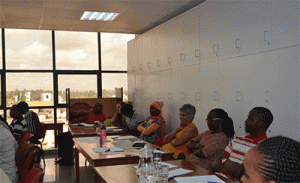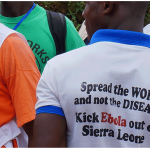Implementing SBCC Tools with Femina Hip (Part Two)
by Catherine Tusajigwe and Lynn O’Rourke
The two-day Social Media Strategy Workshop began on Wednesday, June 25. We arrived at the Femina Hip offices early with enticing snacks in hand. Four guests were invited to give insight into the online and social media world in Tanzania.

The Femina Hip team listening hard and thinking deeply during the social media workshop. Fun activities and work sessions were planned with the Femina Hip social media team, who had been working hard to prepare presentations and provide input and feedback on various documents.
After our participants—the Femina Hip staff and the social media team (20 people total) arrived, we started with a simple reflection activity: “Draw your hand and write down five things you do well. On the other side of the piece of paper, draw your other hand and write down what you need or want to learn. On one hand we all have knowledge, skills and ideas to share, and on the other hand, we all have something to learn.” It was a great way for a group of people who work together on a daily basis to discover hidden talents and interests.
Our first speaker was Emmanuel Feruzi from KINU, a social enterprise working to grow the technology and social landscape in Tanzania. An engaging, thoughtful and insightful speaker, Mr. Feruzi told us about the media lab and their work providing tech education, which jump-started the workshop. We could see the links between what KINU does and what Femina Hip wants to do in the future, and now regard KINU as a future partner in our work.
During the first day, we looked at the social media guidelines that were developed two years ago and discussed aspects that needed to be changed and adjusted to create instead an online and social media strategy document. First, we looked at the underlying assumption which formulated the original guidelines: social media is an integrated part of the daily work of the social media team, but social media should not be the primary focus of staff’s work descriptions and team members may rotate according to needs.
With our new strategic plan and desire to use online and social media in a more targeted way, we questioned if we wanted to change its focus and make online and social media a distinct Femina Hip media product that requires the same resources and attention as our other media products.
We discussed implications of changing the focus throughout the day, which included:
- What this means for the organization in terms of human resources, financial resources and the other media teams.
- What the social media group’s activities would be.
- How to set the short- and long-term goals.
This sparked a lively discussion, but at the end of the day, this essential question was unresolved because making a full commitment to it would require long-term financial resources.
In our next session, we started to use the Family Planning Goes Social (sourced from the Health COMpass team) worksheets and questions, which guided us through understanding why we needed a strategy and set up the topics for the next sessions. We looked at research, analyzed our audience and discussed the direction of online technologies and infrastructure in Tanzania.
Breaking into two groups, Group One looked at the strategy and made suggestions for the short- and long-term goals, while Group Two looked at new online tools and selected the ones that would be interesting and relevant for us to explore. The Health Communicator Tool Kit (sourced from the Health COMpass site) provided the group with useful information on suggesting, testing and selecting tools.
The two groups came back together and as we reviewed the short- and long-term goals, we looked at the suggested tools and chose the ones that would work to help us achieve these goals.
We ended the first day with inspirational guest speakers Jen Orkis from Johns Hopkins University (JHU) and Hafiz Juma from AIM Group. Both gave insight to how they increase their audiences through Facebook advertising campaigns and content creation. Femina Hip resources are more limited, but our process for creating content is as in-depth as the JHU process.
On our second day, we focused on our SMS platform and how to integrate audience feedback from our SMS platform, social media platforms and new website, as well as reviewing our social media policy. Justin Murashani from FHI360 presented the M4H SMS system that is used to communicate information about sexual and reproductive health rights (we are currently working with his team to review the youth content that will be launched in January.) And our second guest speaker that day, Mike Mushi from Jamii Forum, a local open forum site, discussed his vision for the future of online and social media trends and predictions. He was inspirational and gave us new ideas to think about.
Using all of our ideas, inspirations, plans, goals, document changes and decisions, the social media team met together on the third day and developed a plan for the way forward.
We ended the workshop with a celebration for all of our hard work and to recognize each other.
The Femina Hip staff provided workshop feedback—all comments were positive and constructive, such as acknowledging that they gained a new Insight to how to make Social Media successful, and “We are on track and we only need improve and move forward.”
The tools we found on Health COMpass (listed below) inspired, guided and informed us throughout our workshop process. Stay tuned for a more connected, more engaged and more dynamic online and social media presence from Femina Hip!
- Family Planning Goes Social
- Health Communicator Toolkit
- 7 Steps to a Successful Social Media Strategy
Missed part one of the series? Read: Femina Hip Uses HealthCOMpass to Develop Social Media Strategy to Reach Youth Throughout Tanzania








Leave a Reply
Want to join the discussion?Feel free to contribute!